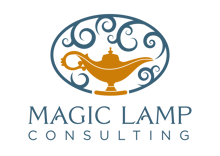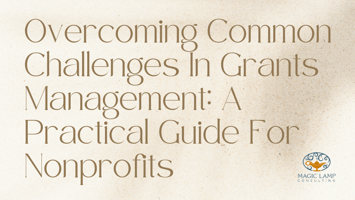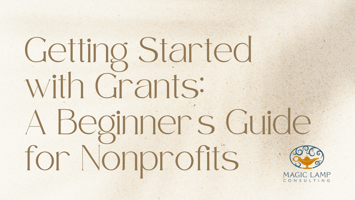Grants play a pivotal role in the sustainability and growth of nonprofit organizations. They...
Next Steps After a Nonprofit is Awarded a Grant
Congratulations! Your nonprofit organization has been awarded a grant. This is a significant achievement that can help your organization achieve its mission and make a meaningful impact in your community. However, the work doesn't end here; it's just beginning. Below are suggested next steps your nonprofit can take to help after a grant is awarded:
1. Acknowledge the Grant Award: As soon as notification of a grant award is received, a thank-you note acknowledging the award should be sent. (I highly recommend a handwritten note). Express your appreciation for the grant and highlight how the funding will impact the community. This is an opportunity to build a relationship with the funder and set the tone for the grant period.
Many nonprofits take the acknowledgment one step further by creating social media content thanking the funder for the grant award. (NOTE: It is important to ensure the funder is open to be public recognition)
2. Review the Grant Agreement: The grant agreement is a legal document that outlines the terms and conditions of the grant. It's essential to review the agreement thoroughly to understand the requirements and restrictions associated with the grant. Pay close attention to reporting deadlines, financial reporting requirements, and other compliance-related information.
Bonus Tip: Notice a specific deadline? Immediately mark it on your calendar. It is essential to remain compliant with the funder's requirements. This helps ensure a trusting relationship starts to grow and will add to credibility should you seek additional funding in the future.
3. Develop a Grant Management Plan: A grant management plan outlines the procedures, policies, and practices that your organization will use to manage the grant. This includes program management, financial management, and reporting requirements. In addition, identifying who is responsible for each step. Develop a plan that aligns with the grant agreement and includes clear procedures for tracking and reporting grant expenditures.
4. Establish a Grant Management System: To ensure successful grant management, the organization needs a system for tracking grant-related activities. This system should include tools for tracking expenses, reporting requirements, and program outcomes. In addition, all staff members involved in grant management should have access to and understand how to use the system. To aid in the process you are welcome to download the Grant Listing Spreadsheet from the Resource Page on Magic Lamp Consulting’s website.
5. Start the Grant-Funded Project: Now it is time to start the project. This may involve hiring staff, purchasing equipment, or launching a new program. All activities need to align with the grant agreement. If there are any unexpected and significant changes to the project, reach out and discuss the suggested changes with the funder.
6. Monitor Progress: Monitoring the program’s progress is essential to ensure that the grant-funded project is on track to meet its goals. Develop a system for tracking program outcomes and regularly report on progress to the funder; this may include site visits, progress reports, and other communication tools.
7. Submit Reports: Reporting is a critical component of successful grant management. All required reports should be submitted on time and with the necessary documentation. Failure to comply with reporting requirements can result in the loss of funding and damage the organization's reputation.
8. Maintain Communication with the Funder: Philanthropy is built on strong relationships between nonprofit organizations and funders. Most funders want more than a transactional experience, they often want to be more invested in the projects and programs they are supporting. This makes it more likely a funder will want to continue the relationship and invest in future projects and programs.
1. Acknowledge the Grant Award: As soon as notification of a grant award is received, a thank-you note acknowledging the award should be sent. (I highly recommend a handwritten note). Express your appreciation for the grant and highlight how the funding will impact the community. This is an opportunity to build a relationship with the funder and set the tone for the grant period.
Many nonprofits take the acknowledgment one step further by creating social media content thanking the funder for the grant award. (NOTE: It is important to ensure the funder is open to be public recognition)
2. Review the Grant Agreement: The grant agreement is a legal document that outlines the terms and conditions of the grant. It's essential to review the agreement thoroughly to understand the requirements and restrictions associated with the grant. Pay close attention to reporting deadlines, financial reporting requirements, and other compliance-related information.
Bonus Tip: Notice a specific deadline? Immediately mark it on your calendar. It is essential to remain compliant with the funder's requirements. This helps ensure a trusting relationship starts to grow and will add to credibility should you seek additional funding in the future.
3. Develop a Grant Management Plan: A grant management plan outlines the procedures, policies, and practices that your organization will use to manage the grant. This includes program management, financial management, and reporting requirements. In addition, identifying who is responsible for each step. Develop a plan that aligns with the grant agreement and includes clear procedures for tracking and reporting grant expenditures.
4. Establish a Grant Management System: To ensure successful grant management, the organization needs a system for tracking grant-related activities. This system should include tools for tracking expenses, reporting requirements, and program outcomes. In addition, all staff members involved in grant management should have access to and understand how to use the system. To aid in the process you are welcome to download the Grant Listing Spreadsheet from the Resource Page on Magic Lamp Consulting’s website.
5. Start the Grant-Funded Project: Now it is time to start the project. This may involve hiring staff, purchasing equipment, or launching a new program. All activities need to align with the grant agreement. If there are any unexpected and significant changes to the project, reach out and discuss the suggested changes with the funder.
6. Monitor Progress: Monitoring the program’s progress is essential to ensure that the grant-funded project is on track to meet its goals. Develop a system for tracking program outcomes and regularly report on progress to the funder; this may include site visits, progress reports, and other communication tools.
7. Submit Reports: Reporting is a critical component of successful grant management. All required reports should be submitted on time and with the necessary documentation. Failure to comply with reporting requirements can result in the loss of funding and damage the organization's reputation.
8. Maintain Communication with the Funder: Philanthropy is built on strong relationships between nonprofit organizations and funders. Most funders want more than a transactional experience, they often want to be more invested in the projects and programs they are supporting. This makes it more likely a funder will want to continue the relationship and invest in future projects and programs.





